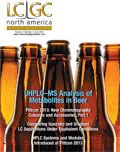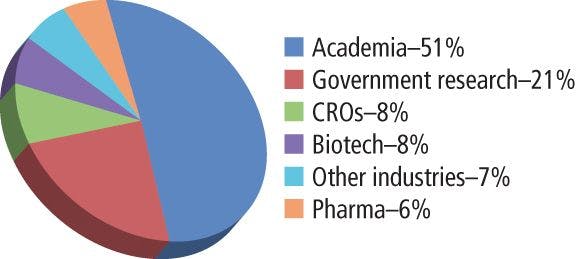Troubleshooting GC Columns and Detectors
Help with common problems with preparation, installation, and care
Gas chromatography (GC) column preparation, installation, and care are of the utmost importance to ensure good chromatographic performance. Here, we will outline some of the common issues that we come across from CHROMacademy members so that you can avoid these pitfalls.
GC columns need to be properly prepared to avoid issues such as high bleed and poor peak shape. If your column was shipped with flame-sealed ends, be sure to trim at least 10 cm from each end to avoid high column bleed associated with the flame-sealing process. Be sure that the column cuts are straight (that is, at 90° to the column outside wall), and not jagged. Angled cuts with rough column edges lead to peak tailing or splitting caused by polar analyte interactions with the excess of silanol groups exposed and the formation of turbulent eddies at the inlet, which holds up analytes from entering the column. Be sure to check the quality of the cut with a magnifying glass (a microscope is better), because the quality of the cut directly affects peak shape and therefore the reproducibility of your integration or quantitative data.
Column installation is critical, and poor installation can lead to reduced efficiency (broad peaks), peak shouldering or splitting, and poor quantitative reproducibility. After you have the column cut properly, follow the manufacturer's instruction regarding insertion distances into both the inlet and detector. A column installed too high in the inlet risks poor quantitative reproducibility, and when a column is installed too low, peak broadening can occur because of the extra dead volume created. At the detector, a column inserted too high will give rise to high baseline noise and spikes with flame-based detectors (as the polyimide column coating burns in the flame!) or again to broad peaks if installed too low. Each column type has a dedicated ferrule size or internal diameter, and gas chromatography–mass spectrometry (GC–MS) ferrules are made from different materials — are you using the correct type? Check with your manufacturer. Oh — and that funny little cup with insulation inside that stops you from getting to the column coupling so you just removed it— well that's probably just lost you some potentially vital plates and degraded the peak shape slightly, so make sure you put it back.
Column conditioning parameters differ with stationary-phase polarity and film thickness, so always check the side of the box for the maximum isothermal and gradient temperatures. But here's a tip to reduce your conditioning effort and save stationary phase — connect the column to the inlet (not the detector) and allow your carrier gas to flow through at ambient temperature for 10–15 min — this helps to purge dissolved oxygen from the stationary phase and significantly reduces conditioning time and subsequent phase loss. Then condition the column by raising the oven temperature at 10 °C/min to the gradient maximum and hold for the required period of time to subsequently obtain a stable baseline — this is almost never longer than 1 h in our experience and may be as short as
10 min for less-polar, thinner-film columns. Fitting carrier-gas traps close to the instrument (to remove oxygen and moisture) is a great way to improve column lifetime and detection limits. Use the plate count of a test analyte to monitor column efficiency and set a column discard limit based on your knowledge of required plate counts for your types of analysis. Columns can often be miraculously restored to life by trimming 5% of the total column length from the inlet end — note that retention times may shift slightly after this operation, but efficiency may increase and peak shapes will improve. Consider using a guard column if your samples are particularly dirty.
Detailed advice on troubleshooting all of the various GC detectors isn't possible in this short column. However, some of the general advice we give to CHROMacademy members follows.
Always ensure you have the correct gases and gas stoichiometry — and measure gas flows manually from time to time to ensure your instrument isn't misleading you. Be aware, for instance, that nitrogen is the best makeup gas for flame ionization detection (FID) and that the detector sensitivity can often be optimized by tweaking makeup gas flow. Another "for instance" in this category is the necessity to change from nitrogen to argon or methane mixtures for certain applications using electron-capture detection (ECD).
Detector noise is almost always associated with dirt, so be sure to have a regular maintenance schedule to check the detector and jet or orifice for cleanliness. Blocked detector jets can lead to horrendous peak tailing. Nitrogen–phosphorus detection noise increases with the age of the bead and ECD noise with aging sources that are no longer producing the same amount of beta particles per unit time or current as they used to. Aging ECD detectors often give a negative dip after analyte peaks.
Baseline drift can often be compensated for by operating in constant flow rather than constant pressure modes. If this isn't the case then consider that either the response or gas flows are changing over time. Is your bottled gas supply running low? Is there an issue with your gas generator?
Happy troubleshooting — and for more information and the world's most advanced interactive GC troubleshooting tool, visit CHROMacademy (www.CHROMacademy.com).

Study Examines Impact of Zwitterionic Liquid Structures on Volatile Carboxylic Acid Separation in GC
March 28th 2025Iowa State University researchers evaluated imidazolium-based ZILs with sulfonate and triflimide anions to understand the influence of ZILs’ chemical structures on polar analyte separation.












